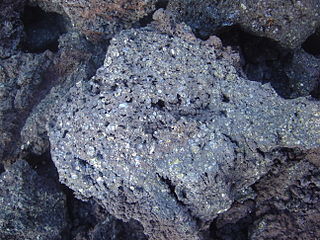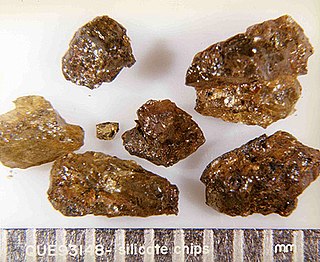
Mafic is an adjective describing a silicate mineral or igneous rock that is rich in magnesium and iron, and is thus a portmanteau of magnesium and ferric. Most mafic minerals are dark in color, and common rock-forming mafic minerals include olivine, pyroxene, amphibole, and biotite. Common mafic rocks include basalt, diabase and gabbro. Mafic rocks often also contain calcium-rich varieties of plagioclase feldspar.

Peridot ( or ) (sometimes called chrysolite) is gem-quality olivine and a silicate mineral with the formula of (Mg, Fe)2SiO4. As peridot is a magnesium-rich variety of olivine (forsterite), the formula approaches Mg2SiO4.

A Chondrule is a round grain found in a chondrite. Chondrules form as molten or partially molten droplets in space before being accreted to their parent asteroids. Because chondrites represent one of the oldest solid materials within the Solar System and are believed to be the building blocks of the planetary system, it follows that an understanding of the formation of chondrules is important to understand the initial development of the planetary system.

Dunite is an igneous, plutonic rock, of ultramafic composition, with coarse-grained or phaneritic texture. The mineral assemblage is greater than 90% olivine, with minor amounts of other minerals such as pyroxene, chromite, magnetite, and pyrope. Dunite is the olivine-rich end-member of the peridotite group of mantle-derived rocks. Dunite and other peridotite rocks are considered the major constituents of the Earth's mantle above a depth of about 400 kilometers. Dunite is rarely found within continental rocks, but where it is found, it typically occurs at the base of ophiolite sequences where slabs of mantle rock from a subduction zone have been thrust onto continental crust by obduction during continental or island arc collisions (orogeny). It is also found in alpine peridotite massifs that represent slivers of sub-continental mantle exposed during collisional orogeny. Dunite typically undergoes retrograde metamorphism in near-surface environments and is altered to serpentinite and soapstone.

Peridotite is a dense, coarse-grained igneous rock consisting mostly of the minerals olivine and pyroxene. Peridotite is ultramafic, as the rock contains less than 45% silica (SiO4−
4). It is high in magnesium (Mg2+), reflecting the high proportions of magnesium-rich olivine, with appreciable iron. Peridotite is derived from the Earth's mantle, either as solid blocks and fragments, or as crystals accumulated from magmas that formed in the mantle. The compositions of peridotites from these layered igneous complexes vary widely, reflecting the relative proportions of pyroxenes, chromite, plagioclase, and amphibole.

Forsterite (Mg2SiO4; commonly abbreviated as Fo; also known as white olivine) is the magnesium-rich end-member of the olivine solid solution series. It is isomorphous with the iron-rich end-member, fayalite. Forsterite crystallizes in the orthorhombic system (space group Pbnm) with cell parameters a 4.75 Å (0.475 nm), b 10.20 Å (1.020 nm) and c 5.98 Å (0.598 nm).

Fayalite (Fe2SiO4; commonly abbreviated to Fa), also called iron chrysolite, is the iron-rich end-member of the olivine solid-solution series. In common with all minerals in the olivine group, fayalite crystallizes in the orthorhombic system (space group Pbnm) with cell parameters a 4.82 Å, b 10.48 Å and c 6.09 Å.

Tephroite is the manganese endmember of the olivine group of nesosilicate minerals with the formula Mn2SiO4. A solid solution series exists between tephroite and its analogues, the group endmembers fayalite and forsterite. Divalent iron or magnesium may readily replace manganese in the olivine crystal structure.

Serpentinite is a rock composed of one or more serpentine group minerals, the name originating from the similarity of the texture of the rock to that of the skin of a snake. Minerals in this group, which are rich in magnesium and water, light to dark green, greasy looking and slippery feeling, are formed by serpentinization, a hydration and metamorphic transformation of ultramafic rock from the Earth's mantle. The mineral alteration is particularly important at the sea floor at tectonic plate boundaries.

Komatiite is a type of ultramafic mantle-derived volcanic rock defined as having crystallised from a lava with ≥ 18 wt% MgO. Komatiites have low silicon, potassium and aluminium, and high to extremely high magnesium content. Komatiite was named for its type locality along the Komati River in South Africa, and frequently displays spinifex texture composed of large dendritic plates of olivine and pyroxene.

Picrite basalt, picrobasalt is a variety of high-magnesium olivine basalt that is very rich in the mineral olivine. It is dark with yellow-green olivine phenocrysts and black to dark brown pyroxene, mostly augite.
The Thermal Emission Spectrometer (TES) is an instrument on board Mars Global Surveyor. TES collects two types of data, hyperspectral thermal infrared data from 6 to 50 micrometres (μm) and bolometric visible-NIR measurements. TES has six detectors arranged in a 2x3 array, and each detector has a field of view of approximately 3 × 6 km on the surface of Mars.
The TES instrument uses the natural harmonic vibrations of the chemical bonds in materials to determine the composition of gases, liquids, and solids.
TES identified a large area that contained the mineral olivine. Olivine was found in the Nili Fossae formation. It is thought that the ancient impact that created the Isidis basin resulted in faults that exposed the olivine. Olivine is present in many mafic volcanic rocks. In the presence of water it weathers into minerals such as goethite, chlorite, smectite, maghemite, and hematite. Olivine was also discovered in many other small outcrops within 60 degrees north and south of the equator. Olivine has also been found in the SNC meteorites that are generally accepted to have come from Mars. Later studies have found the olivine-rich rocks to cover over 113,000 square kilometers. That is 11 times larger than the five volcanoes on the Big Island of Hawaii.

The H type ordinary chondrites are the most common type of meteorite, accounting for approximately 40% of all those catalogued, 46% of the ordinary chondrites, and 44% of the chondrites. The ordinary chondrites are thought to have originated from three parent asteroids, whose fragments make up the H chondrite, L chondrite and LL chondrite groups respectively.

Heazlewoodite, Ni3S2, is a rare sulfur-poor nickel sulfide mineral found in serpentinitized dunite. It occurs as disseminations and masses of opaque, metallic light bronze to brassy yellow grains which crystallize in the trigonal crystal system. It has a hardness of 4, a specific gravity of 5.82. Heazlewoodite was first described in 1896 from Heazlewood, Tasmania, Australia.

Iddingsite is a microcrystalline rock that is derived from alteration of olivine. It is usually studied as a mineral, and consists of a mixture of remnant olivine, clay minerals, iron oxides and ferrihydrites. Debates over iddingsite's non-definite crystal structure caused it to be de-listed as an official mineral by the IMA; thus it is properly referred to as a rock.

Lodranites are a small group of primitive achondrite meteorites that consists of meteoric iron and silicate minerals. Olivine and pyroxene make up most of the silicate minerals. Like all primitive achondrites lodranites share similarities with chondrites and achondrites.

Brachinites are a group of meteorites that are classified either as primitive achondrites or as asteroidal achondrites. Like all primitive achondrites, they have similarities with chondrites and achondrites. Brachinites contain 74 to 98% (Volume) olivine.

Millerite is a nickel sulfide mineral, NiS. It is brassy in colour and has an acicular habit, often forming radiating masses and furry aggregates. It can be distinguished from pentlandite by crystal habit, its duller colour, and general lack of association with pyrite or pyrrhotite.


















